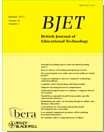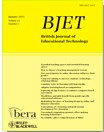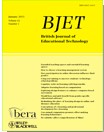-
基础教育
- 教材:
-
- 全部
- 中国地图出版社
- 人教版
- 人教版2012
- 人教版2013版
- 人教版PEP(3年级)
- 人教版义务
- 人教版新课标
- 人教版新起点(1年级)
- 人教版(Go for it)
- 人教版(三年级起点)
- 人教版(三年级起点)2012-2013
- 人教版(版本不明)
- 人教社2016年新编教材
- 冀教版
- 冀教版(三年级起点)
- 北京版
- 北师大版
- 北师大版(2016)
- 北师大版(1年级)
- 北师大版(3年级)
- 北师版2013
- 华东师大版
- 外研社版
- 外研社(三年级起点)
- 外研社(广西专用)
- 广州新版(三年级起点)
- 广州版
- 开心学英语
- 教育科学(3年级起点)
- 教育科学(广州版)
- 新华东师大版
- 新起点英语
- 朗文英语
- 河北版
- 湘少版(3年级起点)
- 牛津上海版
- 牛津上海版(深圳新版)
- 牛津英语
- 粤教版
- 苏教版
- 语文S版
- 语文版
- 首师大版
- 香港现代版
- 齐齐学英语
- 高等教育
- 职业教育
-
From MMORPG to a Classroom Role 普通类
Guest Editorial – Innovations in Designing Mobile Learning Applications
-
Blended e-learning skeleton of conversatio 普通类
The supervision of undergraduate student dissertations is an area in need of research. Although some studies have already addressed this, these are primarily based on academic staff responses. This study contributes to knowledge by gathering the responses of students and focusing on formative electronic assessment. Data was collected using a student focus group and student questionnaire. Unsurprisingly, the findings suggest that good supervisor–student communication is crucial to the supervision process and a number of students felt unhappy with this aspect. However, to facilitate this communication, the perceived absolute necessity of regular supervisor–student meetings is being questioned and a combination of technology-enabled communication is advocated. It is suggested that to improve the undergraduate student dissertation experience, a combination of face-to-face and electronic formative assessment is used. In addition, the blended e-learning skeleton of conversation model provides a sound theoretical framework that could guide supervisors and students in the supervision process. This model is advocated for use in dissertation module design and in supervisor development.
-
Perceptions of Computer-Assisted Writing Program 普通类
Guest Editorial – Innovations in Designing Mobile Learning Applications
-
Using SOLO to Evaluate an Educational Environment 普通类
Guest Editorial – Innovations in Designing Mobile Learning Applications
-
Catalytic assessment understanding how MCQs and 普通类
One technology for education whose adoption is currently expanding rapidly in UK higher education is that of electronic voting systems (EVS). As with all educational technology, whether learning benefits are achieved depends not on the technology but on whether an improved teaching method is introduced with it. EVS inherently relies on the multiple-choice question (MCQ) format, which many feel is associated with the lowest kind of learning of disconnected facts. This paper, however, discusses several ways in which teaching with MCQs, and so with EVS, has transcended this apparent disadvantage, has based itself on deep learning in the sense of focusing on learning relationships between items rather than on recalling disconnected true–false items, and so has achieved substantial learning advantages. Six possible learning designs based on MCQs are discussed, and a new function for (e-)assessment is identified, namely catalytic assessment, where the purpose of test questions is to trigger subsequent deep learning without direct teaching input.
-
Computer Games for the Math Achievement 普通类
Guest Editorial – Innovations in Designing Mobile Learning Applications
-
Mathematical power of special-needs pupils An 普通类
This paper reports a study aimed at revealing special-educational-needs pupils' learning potential by means of an ICT-based assessment including a dynamic visual tool that might help pupils when solving mathematics problems. The study focused on subtraction problems up to 100, which require ‘borrowing’. These problems, in which the value of the ones-digit of the subtrahend is larger than the ones-digit of the minuend, are known as a serious difficulty for weak pupils in mathematics. Seven of such problems from a standardised test were placed in the ICT environment. Data were collected from two test conditions: the standardised written test format and the ICT version of the test items including the tool that provided pupils with a set of virtual manipulatives. The 37 pupils involved in the study were 8–12 years old and from two special-education schools in the Netherlands. Comparison of the performance scores in the two formats showed that an ICT-based assessment format, including a dynamic visual tool, can reveal weak pupils' learning potential and strategy use. The study also pointed out that ‘partial-tool use’, ie, not carrying out the complete subtraction operation with the tool, can provide sufficient support to find the correct answer.
-
Diffusion of Web Supported Instruction 普通类
Guest Editorial – Innovations in Designing Mobile Learning Applications
-
How Epistemic Beliefs Influence e-Learning 普通类
Guest Editorial – Innovations in Designing Mobile Learning Applications
-
Examining the Roles of Blended Learning Approaches 普通类
Guest Editorial – Innovations in Designing Mobile Learning Applications




